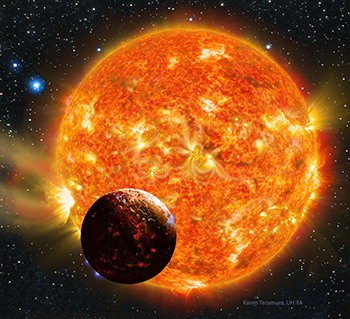
Artist’s rendering of Earth-sized, rocky exoplanet Kepler 78b at close proximity to its parent star.
An international team of astronomers has found the first rocky, Earth-sized planet using data from the Kepler Space Telescope (Nature. doi:10.1038/nature.2013.14058). The exoplanet, dubbed Kepler-78b, is one of more than 3,500 candidate exoplanets identified by the Kepler mission since its launch three years ago. While many Earth-sized planets have been identified during the mission, Kepler-78b is the first one for which both the mass and size can be estimated, enabling the calculation of its density.
Roberto Sanchis-Ojeda at Massachusetts Institute of Technology (U.S.A.) identified the planet from transit data obtained by the Kepler spacecraft. He found that Kepler-78b orbits very quickly in only 8.5 hours around its parent star, located 400 light years away toward the constellation Cygnus. The planet is so close to the star that it would be far too hot to harbor life.
Because the orbit is so near to its parent star, Kepler-78b causes an observable back-and-forth “wobble” in observations of the star. Andrew Howard and his team at the University of Hawaii at Manoa (U.S.A.) measured the wobble using the High Resolution Echelle Spectrometer on the 10-m Keck 1 Telescope at the W.M. Keck Observatory to determine the mass of Kepler-78b—about 1.69 times that of Earth.
This matched results from a companion study using the High Accuracy Radial Velocity Planet Searcher-North (HARPS-N) spectrograph at the National Galileo Telescope on La Palma, one of the Canary Islands, in which another team independently verified the planet’s mass at 1.86 times that of the Earth. The results are published in the same issue of Nature.
The radius of the planet is 1.2 times larger than that of Earth, which indicates a mean density of 5.3 g/cm3. This is similar to the density of Earth, suggesting a core of rock and iron. However, its surface is thought to reach a scorching 2,300 to 3,100 Kelvin, which is likely to make its iron-rich crust more lava-like than rocky.
